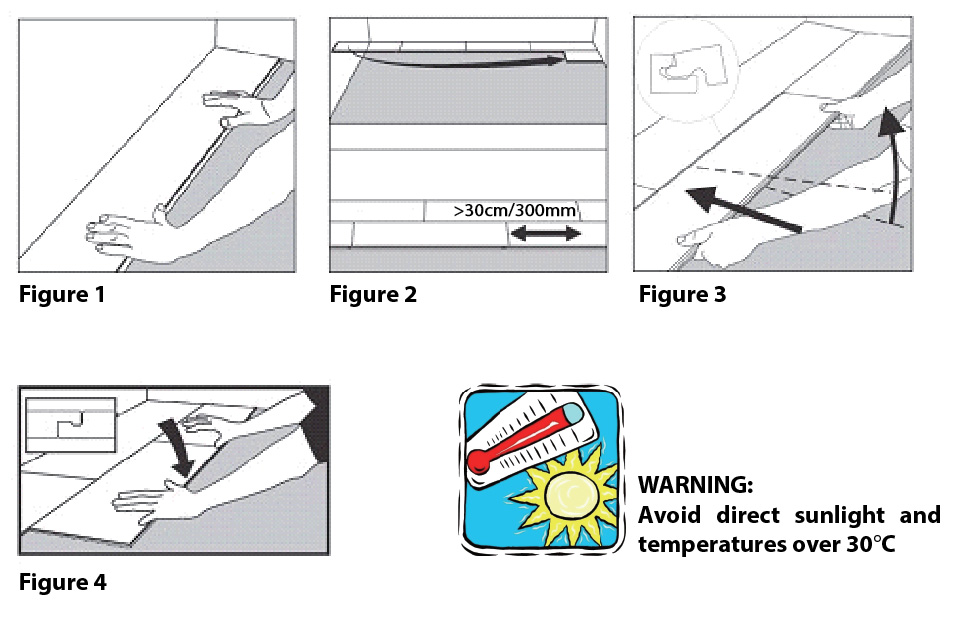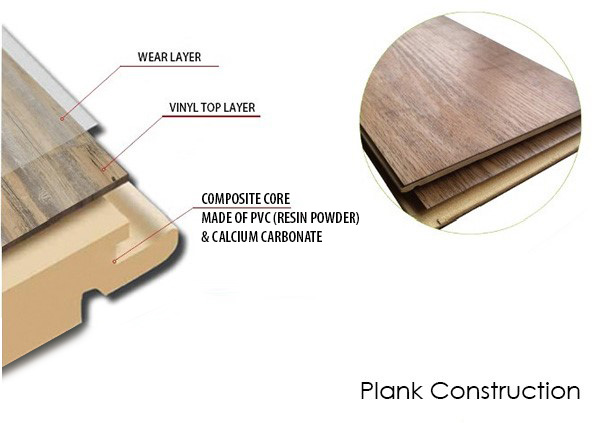Installation Instructions – Symphony EVP
PLEASE READ ALL INSTRUCTION, CAREFULLY, BEFORE YOU BEGIN INSTALLATION, IMPROPER INSTALLATION WILL VOID WARRANTY
INSTALLATION GUIDE:
Dear Customer, you have just purchased an EVP flooring product, produced with the latest technologies. Its exclusive hybrid composition guarantees you optimal performance in humid and temperate situations where other types of PVC flooring are unadvisable.
KEY INSTALLATION METHODS
*
Subfloor Flatness Tolerances
Vapor Barrier (6 mil polyfilm)
Is underlayment (pad) recommended
Important Acclimation Requirements
Transition Requirements (T-Mold) for Large Spaces
Transition Requirements (T-Mold) Doorways/Thresholds
Installation over existing ceramic tile floor
Glue Down Installation
Subfloor RH/MVER (Moisture vapour
emission rate) recommendations
Radiant Heat
Perimeter Expansion requirements
Optimal Interior Environmental Conditions
Definition of
“Waterproof”
Residential
Flat to 4.7mm per 3.3meter radius
Recommended
Yes – Woodlay Underlay
24 – 48 Hours
Required when in excess of recommended floor coverage.
N.B. Recommended coverage in an uncontrolled environment is 10lin.m x 10lin.m
Required if outside of recommended floor coverage
Filling in grout lines wider than 5mm/deeper than 5mm is required
Not recommended
85% RH/8 lbs MVER (Moisture vapour emission rate)
Not to exceed 30° C
Expansion gap must be from 6-15mm depending on the total floor coverage and covered with a 1⁄4 round/skirting on perimeter walls & around heavy fixed objects
18°– 30°C 60% – 80% RH
Structural integrity of flooring will not degrade due to contact with moisture/water
Commercial
Flat to 4.7mm per 3.3meter radius
Recommended
Yes – Woodlay Underlay
48 Hours
Required – Rooms < 30m in any direction - in a controlled
N.B. Recommended coverage in an uncontrolled environment is 10lin.mx10lim.m
Required if outside of recommended floor coverage
Filling in grout lines wider than 5mm/deeper than 5mm is required
Not recommended
85% RH/8 lbs MVER (Moisture vapour emission rate)
Not to exceed 30° C
Expansion gap must be from 6-15mm depending on the total floor coverage and covered with a 1⁄4 round/skirting on perimeter walls & around heavy fixed objects
18°– 30°C 60% – 80% RH
Structural integrity of flooring will not degrade due to contact with moisture/water
PRE-INSTALLATION SUBFLOOR REQUIREMENTS
All Subfloors must be:
- Dry
- Structurally sound
- Clean: Thoroughly swept and free of all debris
- Level: Flat to 4.7mm per 3.3 meters radius
Wood sub-floors must be dry and well secured. Nail or screw every 15cm along joists to avoid squeaking. If not level,
sand down high spots and fill low spots with a leveling patch. Make sure all crawl space are open & has proper
ventilation.
Concrete subfloors must be fully cured, at least 60 days old, and should have minimum 6-mil polyfilm/or 200 micron
polyethylene sheeting between concrete and ground. Subfloor should be flat and level within 4.7mm per 3.3 meters.
If necessary grind high spots down and level low spots with a leveling compound.
Installation Instructions
Engineered Vinyl Planks
Ceramic Tile, resilient tile and sheet vinyl must be well bonded to subfloor, in good condition, clean and level. Do not
sand existing vinyl floors, as they may contain asbestos.
INSTALLATION TOOLS
- Tape measure
- Tapping block (trimmed piece of flooring)
- Pencil
- Pry bar or pull bar
- Chalk line
- Crosscut power saw / Guillotine
- 3M Scotch-Blue™ 2080 Tape
- Rubber mallet
STARTING YOUR INSTALLATION
Work from several open boxes of flooring and “dry lay” the floor before permanently laying the floor. This will allow
you to select the varying grains & colors and to arrange them in a harmonious pattern. Remember, it is the installers’
responsibility to determine the expectations of what the finished floor will look like with the end user first and then to
cull out pieces that do not meet those expectations.
Begin installation next to an outside wall. This is usually the straightest and best reference for establishing a straight
working line. Establish this line by measuring an equal distance from the wall at both ends and snapping a chalk line.
The distance you measure from the wall should be the width of a plank. You may need to scribe cut the first row of
planks to match the wall in order to make a straight working line if the wall is out of straight.
You may want to position a few rows before starting installation to confirm your layout decision and working line.
When laying flooring, stagger end joints from row to row by at least 30cm/300mm. When cutting the last plank in a
row to fit, you can use the cut-off end to begin the next row. If cut-off end is 30cm/300mm in length or less, discard it
and instead cut a new plank at a random length and use it to start the next row. Always begin each row from the same
side of the room. When near a wall, you can use a pry bar to pry close the side and end joints.
INSTALLATION INSTRUCTIONS
Inspection: Prior to installation, inspect planks in daylight for visible faults/damage. Check if subfloor/site conditions
comply with the specifications described in these instructions. If you are not satisfied do not install, and contact your
supplier.
Before laying: Measure the room at right angle to the direction of the planks. For best visual effect, planks in the final
row should be at least 50mm wide (minimum), or half width of plank. For this purpose, planks in the first row can be
cut to smaller size. Shuffle planks in order to obtain a pleasant blend of shades. Lay planks preferably following the
direction of the main source of light. We recommend laying on wooden floors crossways to the existing floorboard.
Planks must not be nailed or screwed to the subfloor. Baseboards and molding must not be fixed in a way which
restricts the movement of the floor.
INSTALLING THE FIRST ROW:
1. Starting from the Right with the tongue facing the wall, carefully place the first board in place. (Figure 1)
2. Align the next piece by overlapping the end of the first board. Press down firmly to lock short end, preferably
by tapping on joint with a rubber mallet. Continue in this manner until reaching the final plank in the first
row.
3. Cut the final board piece to length.
CONTINUING THE INSTALLATION:
1. Begin the second row with the cut piece from the first row. (Figure 3) If the cut piece is shorter than
30cm/300mm, do not use it. Instead, begin with a new board that is at least 30cm/300mm in length and
allows 30cm/300mm between the end joints on the adjacent planks.
2. Position the first board in place by angling it up slightly, pushing forward and interlocking the side tongue.
(Figure 2) Slide the board to the left as necessary to align the edges of the end joint.
3. Carefully push the board down until the tongue and groove lock together on the side and ends.
Installation Instructions
Engineered Vinyl Planks
4. Press down firmly on end joint, preferably tapping with a rubber mallet to fully engage short end.
5. Install the remaining boards and rows in the same manner. (Figures 3 & 4)
6. Cut the last board to size. If necessary, complete the tight fit by tapping the board into place with a pull bar.
7. Whenever practical, use cut pieces from previous rows as the starter board to reduce waste.
8. Maintain 30cm/300mm spacing between end joints after the first four rows for best appearance.

Warning: Heating mats work very well under carpet, tile and stone, however we do not recommend to have them
placed directly underneath the Vinyl EVP floor. It is best to install Vinyl EVP flooring over embedded floor heating
systems. Refer to manufacturer/distributor for installation & operating instructions.


